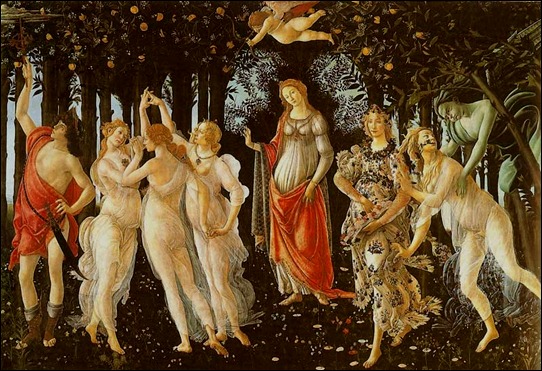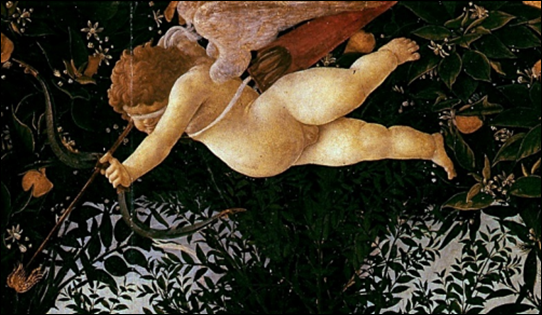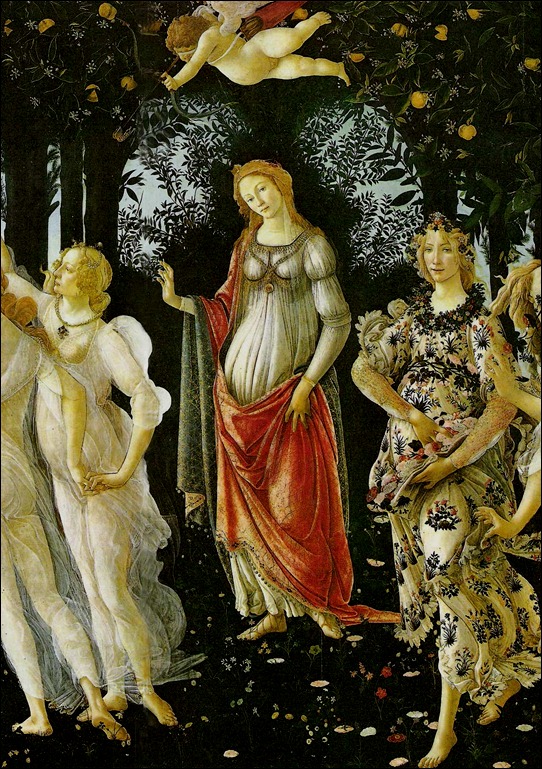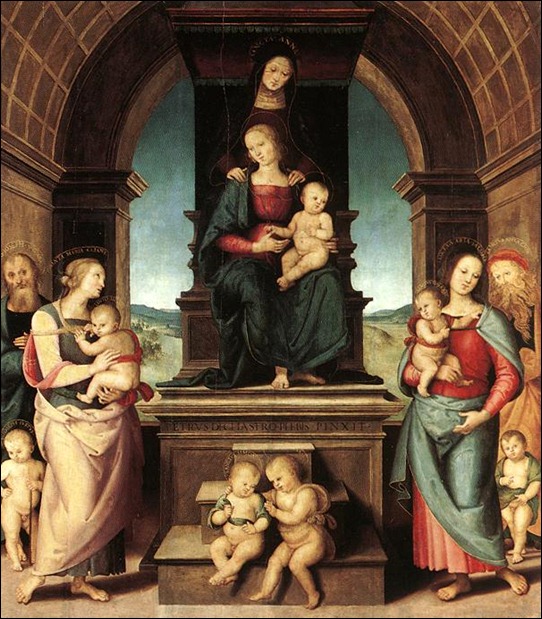La Primavera di Botticelli Posted by Serena on Apr 18, 2013 in Uncategorized
Dopo un lungo e piovoso inverno che sembrava non voler mai finire, all’improvviso è scoppiata la primavera in tutto il suo splendore: sull’erba tornata verde mazzi di primule, narcisi e giunchiglie si alternano a violette e iris, mentre i prati sono bianchi, azzurri e gialli di margheritine, veronica e tarassaco. Contro il cielo azzurro si stagliano gli alberi in fiore, dal bianco al rosa: albicocchi, ciliegi, susini e meli. L’aria profuma di fiori e di piante aromatiche: mentuccia, melissa e timo, mentre tutt’intorno risuona il canto degli uccelli e … il ronzio di motoseghe e decespugliatori!
This sudden awakening of Mother Nature makes me think of Sandro Botticelli’s “La Primavera”, which I had the pleasure of seeing several years ago in the Galleria degli Uffizi in Firenze. This famous much written about painting is considered one of the most controversial in the world because it’s open to various types of interpretation: philosophically it can be seen as an illustration of Neo-platonic love; historically as a portrait of the Medici family; and mythologically as an allegory of the lush growth of Spring. Whilst you’re reading this blog you might like to listen to Ottorino Respighi’s musical interpretation of the painting ‘Primavera’, from his Trittico Botticelliano. Click on the image below to listen.
From a mythological point of view, the painting should be read from right to left. The scene is set in the Garden of the Hesperides, Hera’s blissful orchard in the west, where immortality-giving fruit trees grow (whether golden apples or oranges it’s not sure). The following is the most generally agreed interpretation of the painting:
The winged figure on the right is the first wind of Spring, Zephyrus, who is seen kidnapping the nymph Chloris. As she’s seduced away, flowers spring from her mouth and she becomes Flora, goddess of flowers, the female figure next to her in the flowery dress, who’s scattering flowers around her.
In the centre, framed in an arch created by the orange trees and somewhat separated from the other characters is a woman draped in red, the goddess Venus, who presides over the garden. Above her is the blindfolded figure of Cupid, god of love and son of Venus.
With his bow and arrow Cupid is targeting the group on the left: the three Graces (beauty, joy and charm). Their hands are twined together as they perform a dance.
On the far left is a young male figure draped in red with a sword and a helmet. This is Mercury, who guards the garden. With his right arm he raises his caduceus, a wooden rod, to drive away the threatening grey clouds.
The painting can also be interpreted as an illustration of the ideal of Neo-platonic love which was very popular amongst the Medici (who likely commissioned the painting) and their followers. The Neo-platonic philosophers saw Venus as ruling over both earthly love (the group on the right) and divine love (the group on the left) and argued that she was the classical equivalent of the Virgin Mary. In fact if you look at the way in which she is framed in an altar-like setting you’ll find that it is similar to contemporary images of the Virgin Mary.
Sopra: Perugino – Famiglia della Madonna, 1500-1502, olio su tavola

Build vocabulary, practice pronunciation, and more with Transparent Language Online. Available anytime, anywhere, on any device.








Comments:
Carolina Gengo:
at first glance the central figure does look like the Virgin Mary, and pregnant? with the baby Jesus? Perhaps. in any case a symbol of divinity, certainly one of love.
Serena:
@Carolina Gengo Salve Carolina!
I agree with your reading of the female figure in the centre, Venus, very similar in its iconography to the Virgin Mary.
Saluti da Serena
Il gran giovann”:
Isn’t the model for Mars Lorenzo de’ Medici? And wasn’t the painting commissioned for his wedding? And didn’t it serve as neoplatonic piece of instruction for his bride? Or did I fall asleep in my renaissance art history class and dream all of the above? (If so, it was nice dream) I do remember reading a recent scholarly article on the painting that went into these matterss. Anyone with better info?
Thanks for the wonderful music!
Serena:
@Il gran giovann" Salve!
It’s generally agreed that the figure on the left is Mercury, the guardian of the garden, but some scholars see in him Mars. It’s believed to be Lorenzo di Pierfrancesco de Medici, cousin of Giuliano de Medici, therefore not the more famous Lorenzo de Medici known as il Magnifico. The painting is meant to represent the wedding of Lorenzo di Pierfrancesco to Semiramide Appiani, the Grace in the middle of the group. The neoplatonic philosophy behind it is the contraposition of the sensual/irrational love represented by group on the right (Zephyr and Clorys) to the more spiritual love represented by the group on the left: the three Graces (Voluptas, Castitas and Pulchritudo). But this is only one of the many interpretations given to this famous painting.
Saluti da Serena